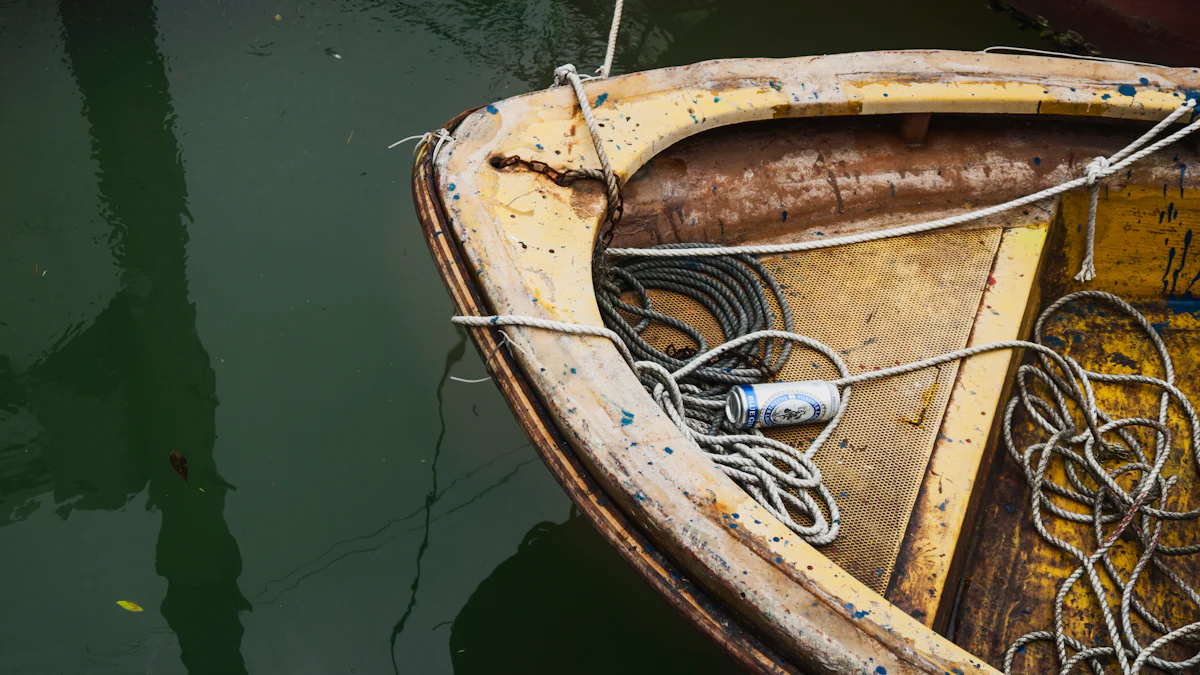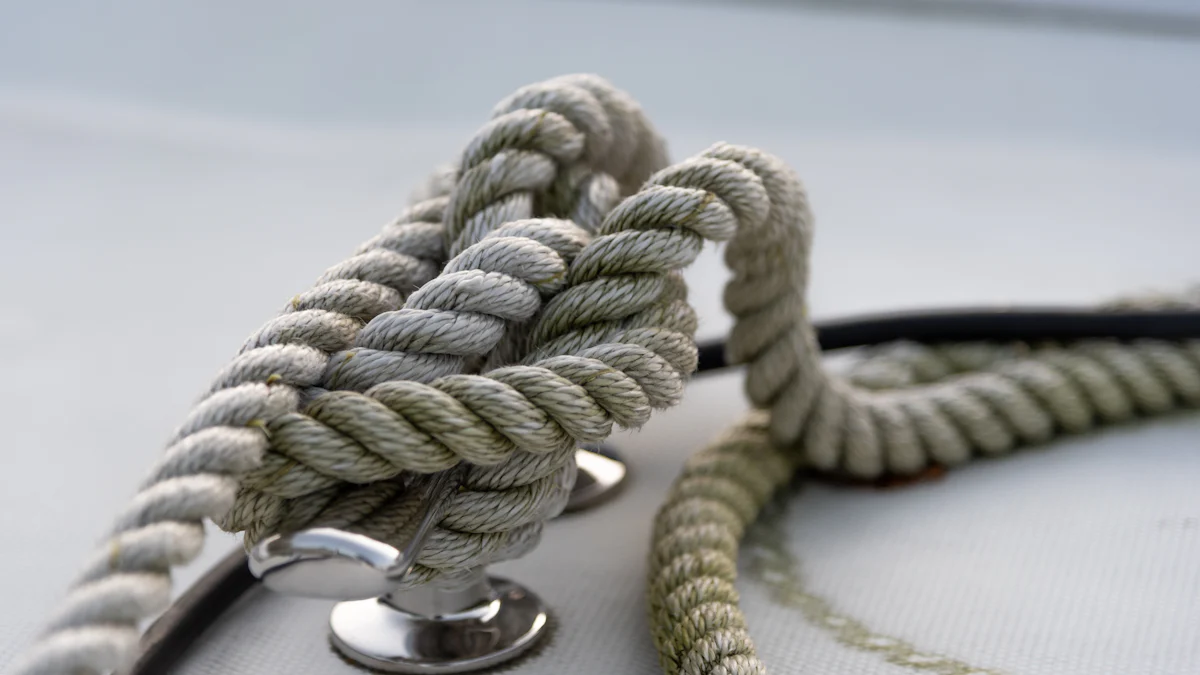Rope Stretch: Understanding Elasticity in Mooring Lines

Elasticity in mooring ropes is vital for maritime operations, ensuring the safety and stability of vessels by absorbing the natural forces of waves and wind. This elasticity prevents boats from buckling into the mooring lines, enhancing onboard comfort and reducing jerky motions.
The importance of mooring rope stretch becomes evident when considering failure statistics. A single mooring line failure occurs every 20 rig years, while a multi-line failure happens every 100 rig years.
Proper inspection and maintenance can prevent many accidents, highlighting the need for understanding elasticity in mooring systems.
Basic Principles of Elasticity in Mooring Lines

Definitions and Key Terms
Elastic Stiffness
Elastic stiffness refers to the resistance a mooring line exhibits when subjected to stretching forces. This property determines how much a rope can stretch under a given load. High elastic stiffness means the rope will not stretch much, while low stiffness allows for more elongation. Understanding elastic stiffness is crucial for selecting the right mooring line, as it directly impacts the vessel's stability and safety. For instance, ropes with appropriate stiffness can absorb wave energy, reducing the risk of sudden jerks that might destabilize a vessel.
Creep Behavior
Creep behavior describes the gradual and irreversible elongation of mooring lines over time when they are under constant stress. This phenomenon occurs due to the molecular structure of the rope materials, which slowly rearrange under prolonged tension. Creep can affect the long-term performance of mooring lines, leading to potential safety hazards if not monitored. Regular inspection and maintenance help mitigate the risks associated with creep, ensuring the mooring system remains reliable.
Factors Affecting Elasticity
Temperature
Temperature significantly influences the elasticity of mooring lines. High temperatures can soften the fibers, increasing their stretchability, while low temperatures may make them more rigid. This temperature-dependent behavior necessitates careful consideration when choosing mooring lines for different maritime environments. For example, vessels operating in tropical regions might require ropes with different elasticity characteristics compared to those used in colder climates.
Load Duration
The duration for which a load is applied to a mooring line also affects its elasticity. Prolonged loading can lead to increased stretching and potential deformation of the rope. This factor is particularly important in scenarios where vessels remain docked for extended periods. Understanding the impact of load duration helps in selecting mooring lines that maintain their performance over time, ensuring vessel safety and operational efficiency.
Research Findings on Mooring Line Elasticity and Vessel Safety highlight the importance of understanding factors like material composition, diameter, and construction method. These elements play a crucial role in determining the elasticity levels of mooring lines, which in turn affect vessel safety and performance.
Materials Used in Mooring Ropes
Synthetic Fibers in Mooring Lines
Mooring ropes rely heavily on synthetic fibers due to their unique properties. These fibers offer a combination of strength, elasticity, and durability, making them ideal for maritime applications.
Nylon
Nylon mooring lines stand out for their exceptional elasticity. They can stretch significantly under load, which helps absorb shocks and reduces the risk of sudden jerks. This feature makes them particularly suitable for vessels that encounter dynamic conditions, such as rough seas or strong winds. The ability to stretch and return to their original length without permanent deformation ensures that nylon ropes maintain their performance over time.
Polyester
Polyester ropes provide a balanced combination of strength and elasticity. While they do not stretch as much as nylon, they offer adequate working stretch, which is beneficial for absorbing surge loads. Polyester's resistance to UV rays and abrasion makes it a popular choice for long-term mooring applications. Its moderate elasticity ensures that it can handle the stresses of mooring without compromising safety.
Polypropylene
Polypropylene ropes offer slightly more stretch than polyester, making them a versatile option for various mooring scenarios. They are lightweight and resistant to water absorption, which enhances their buoyancy. Although polypropylene ropes are not as strong as nylon or polyester, their cost-effectiveness and flexibility make them suitable for temporary or less demanding mooring tasks.
Material Properties and Elasticity
Understanding the material properties of mooring ropes is crucial for selecting the right type for specific maritime needs. Two key properties that influence elasticity are tensile strength and flexibility.
Tensile Strength
Tensile strength refers to the maximum load a rope can withstand before breaking. High tensile strength is essential for mooring ropes, as it ensures they can handle the forces exerted by waves, wind, and vessel movements. Synthetic fibers like nylon and polyester are known for their high tensile strength, which contributes to their reliability in mooring applications.
Flexibility
Flexibility determines how easily a rope can bend without breaking. Flexible ropes can absorb energy from external forces, reducing the impact on the vessel and mooring system. Nylon ropes, with their high elasticity, offer excellent flexibility, making them ideal for dynamic conditions. Polyester and polypropylene also provide sufficient flexibility, ensuring that they can adapt to various mooring requirements.
Practical Applications of Mooring Rope Stretch

Mooring rope stretch plays a crucial role in enhancing the functionality and safety of maritime operations. Its practical applications extend beyond mere attachment, offering significant benefits in terms of onboard comfort and safety.
Enhanced Onboard Comfort
Vibration Dampening
Mooring ropes with optimal stretch characteristics effectively dampen vibrations caused by waves and wind. This dampening reduces the transmission of vibrations to the vessel, ensuring a smoother ride for passengers and crew. By absorbing these vibrations, mooring ropes contribute to a more stable and comfortable onboard environment, minimizing the discomfort associated with constant motion.
Shock Absorption
The ability of mooring ropes to stretch under load provides excellent shock absorption. When a vessel encounters sudden forces, such as strong gusts of wind or unexpected waves, the elasticity of the ropes absorbs the impact. This absorption prevents abrupt movements that could lead to equipment damage or personal injury. The shock-absorbing properties of mooring ropes are essential for maintaining the integrity of the vessel and ensuring the safety of those on board.
Safety Benefits of Mooring Lines
Load Distribution
Mooring rope stretch facilitates even load distribution across the mooring system. By allowing the ropes to elongate under tension, the forces exerted by the vessel are spread more evenly. This distribution reduces the strain on individual lines, preventing overloading and potential failure. Proper load distribution enhances the overall stability of the mooring system, contributing to the vessel's safety.
Risk Mitigation
The elasticity of mooring ropes plays a vital role in risk mitigation. By accommodating the dynamic forces encountered in maritime environments, these ropes reduce the likelihood of line breakage. The ability to stretch without permanent deformation ensures that mooring lines remain reliable over time. Regular inspection and maintenance further enhance their performance, minimizing the risk of accidents.
COSCO mooring lines still going strong after 11,000 hours demonstrates the reliability and efficiency of mooring rope stretch in real-world applications. This case highlights how well-designed mooring systems can withstand prolonged use while maintaining their effectiveness.
Implications for Mooring System Design
Understanding Stretch Characteristics
Design Considerations
Designers must consider the stretch characteristics of mooring lines to ensure effective mooring system performance. The elasticity of a rope influences how it responds to external forces such as waves and wind. Designers should select materials that provide the necessary stretch to absorb these forces without compromising the vessel's stability. Proper selection and use of mooring lines can significantly impact overall vessel performance and protection against external forces. By understanding the stretch characteristics, designers can create systems that enhance safety and efficiency.
Performance Optimization
Optimizing performance involves balancing elasticity with other material properties like tensile strength and flexibility. Designers aim to achieve a mooring system that can withstand environmental stresses while maintaining its integrity over time. Strength requirements are useful to assess the suitability of a mooring design, but they do not provide insight into the reliability of the mooring system. By focusing on performance optimization, designers ensure that mooring systems remain reliable and effective in various maritime conditions.
Ensuring Reliability and Safety
Regular Maintenance
Regular maintenance plays a crucial role in ensuring the reliability and safety of mooring systems. Over time, mooring lines may experience wear and tear, affecting their elasticity and overall performance. Maintenance activities include inspecting ropes for signs of damage, replacing worn-out lines, and ensuring that all components function correctly. By conducting regular maintenance, operators can prevent potential failures and extend the lifespan of the mooring system.
Monitoring and Testing
Monitoring and testing are essential for maintaining the safety and reliability of mooring systems. Operators should regularly assess the condition of mooring lines and evaluate their performance under different conditions. Testing helps identify any issues with elasticity or other material properties that could compromise the system's effectiveness. By implementing a robust monitoring and testing program, operators can ensure that mooring systems remain safe and reliable, providing peace of mind for maritime operations.
Future Trends and Innovations in Mooring Ropes
Advances in Material Technology
Smart Fibers
Smart fibers represent a significant advancement in mooring rope technology. These fibers integrate sensors and digital capabilities, allowing them to monitor their own condition and performance. By providing real-time data on stress, strain, and environmental conditions, smart fibers enhance the safety and reliability of mooring systems. They enable operators to make informed decisions about maintenance and replacement, reducing the risk of unexpected failures. As technology evolves, the integration of smart fibers into mooring ropes will likely become more widespread, offering new levels of insight and control.
Eco-friendly Materials
The maritime industry increasingly focuses on sustainability, driving the development of eco-friendly materials for mooring ropes. Manufacturers explore alternatives to traditional synthetic fibers, aiming to reduce environmental impact without compromising performance. These materials often come from renewable sources or incorporate biodegradable components, minimizing pollution and waste. The shift towards eco-friendly materials aligns with global efforts to promote sustainable practices in all industries. As these materials become more prevalent, they will play a crucial role in reducing the environmental footprint of maritime operations.
Impact on Mooring Practices
Automation
Automation is transforming mooring practices by streamlining operations and enhancing efficiency. Automated mooring systems use advanced technologies to secure vessels quickly and safely, reducing the need for manual intervention. These systems improve precision and consistency, minimizing human error and increasing safety. Automation also allows for faster turnaround times in ports, boosting productivity and reducing costs. As the maritime industry continues to embrace automation, mooring practices will become more efficient and reliable, benefiting operators and stakeholders alike.
Predictive Analytics
Predictive analytics leverages data to forecast future events and trends, offering valuable insights for mooring operations. By analyzing historical data and current conditions, predictive analytics can identify potential issues before they occur, enabling proactive maintenance and risk management. This approach helps operators optimize mooring strategies, ensuring that systems remain safe and effective over time. As data collection and analysis technologies advance, predictive analytics will become an integral part of mooring practices, enhancing decision-making and operational efficiency.
Understanding elasticity in mooring lines is vital for maritime safety and efficiency. Elasticity allows mooring ropes to absorb shock loads and distribute stress, ensuring vessel stability. Selecting the right mooring lines with appropriate elasticity levels is essential for safe docking and mooring operations.
"Mooring line elasticity is crucial for ensuring vessel safety and performance by absorbing shock loads and distributing stress effectively."
Incorporating elasticity into mooring line design enhances safety and optimizes performance, making it a key consideration for maritime professionals.



